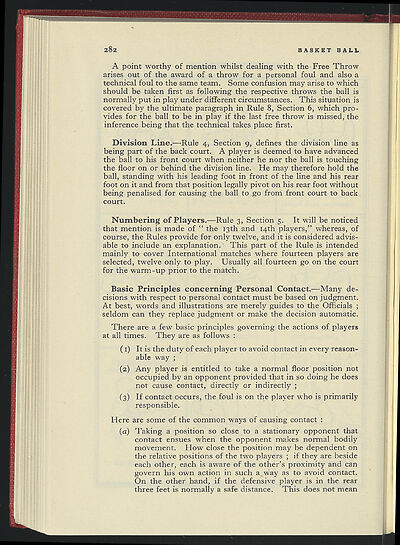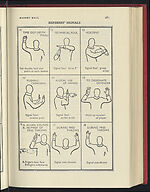1957-58
(298)
Download files
Complete book:
Individual page:
Thumbnail gallery: Grid view | List view

282
BASKET BALL
A point worthy of mention whilst dealing with the- Free Throw
arises out of the award of a throw for a personal foul and also a
technical foul to the same team. Some confusion may arise to which
should be taken first as following the respective throws the ball is
normally put in play under different circumstances. This situation is
covered by the ultimate paragraph in Rule
8,
Section 6, which pro-
vides for the ball to be in play if the last free throw is missed, the
inference being that the technical takes place first.
Division Line.
—Rule 4, Section 9, defines the division line as
being part of the back court. A player is deemed to have advanced
the ball to his front court when neither he nor the ball is touching
the floor on or behind the division line. He may therefore hold the
ball, standing with his leading foot in front of the line and his rear
foot on it and from that position legally pivot on his rear foot without
being penalised for causing the ball to go from front court to back
court.
Numbering of Players.
—Rule 3, Section 5. It will be noticed
that mention is made of " the 13th and 14th players," whereas, of
course, the Rules provide for only twelve, and it is considered advis-
able to include an explanation. - This part of the Rule is intended
mainly to cover International matches where fourteen players are
selected, twelve only to play. Usually all fourteen go on the court
for the warm-up prior to the match.
Basic Principles concerning Personal Contact.
—Many de-
cisions with respect to personal contact must be based on judgment.
At best, words and illustrations are merely guides to the Officials ;
seldom can they replace judgment or make the decision automatic.
There are a few basic principles governing the actions of players
at all times. They are as follows :
(1)
It is the duty of each player to avoid contact in every reason-
able way ;
(2)
Any player is entitled to take a normal floor position not
occupied by an opponent provided that in so doing he does
not cause contact, directly or indirectly ;
If contact occurs, the foul is on the player who is primarily
responsible.
Here are some of the common ways of causing contact :
(a) Taking a position so close to a stationary opponent that
contact ensues when the opponent makes normal bodily
movement. How close the position may be dependent
on
the relative positions of the two players ; if they are beside
each other, each is aware of the other's proximity and can
govern his own action in such a way as to avoid contact.
On the other hand, if the defensive player is in the rear
three feet is normally a safe distance. This does not mean
(3)
BASKET BALL
A point worthy of mention whilst dealing with the- Free Throw
arises out of the award of a throw for a personal foul and also a
technical foul to the same team. Some confusion may arise to which
should be taken first as following the respective throws the ball is
normally put in play under different circumstances. This situation is
covered by the ultimate paragraph in Rule
8,
Section 6, which pro-
vides for the ball to be in play if the last free throw is missed, the
inference being that the technical takes place first.
Division Line.
—Rule 4, Section 9, defines the division line as
being part of the back court. A player is deemed to have advanced
the ball to his front court when neither he nor the ball is touching
the floor on or behind the division line. He may therefore hold the
ball, standing with his leading foot in front of the line and his rear
foot on it and from that position legally pivot on his rear foot without
being penalised for causing the ball to go from front court to back
court.
Numbering of Players.
—Rule 3, Section 5. It will be noticed
that mention is made of " the 13th and 14th players," whereas, of
course, the Rules provide for only twelve, and it is considered advis-
able to include an explanation. - This part of the Rule is intended
mainly to cover International matches where fourteen players are
selected, twelve only to play. Usually all fourteen go on the court
for the warm-up prior to the match.
Basic Principles concerning Personal Contact.
—Many de-
cisions with respect to personal contact must be based on judgment.
At best, words and illustrations are merely guides to the Officials ;
seldom can they replace judgment or make the decision automatic.
There are a few basic principles governing the actions of players
at all times. They are as follows :
(1)
It is the duty of each player to avoid contact in every reason-
able way ;
(2)
Any player is entitled to take a normal floor position not
occupied by an opponent provided that in so doing he does
not cause contact, directly or indirectly ;
If contact occurs, the foul is on the player who is primarily
responsible.
Here are some of the common ways of causing contact :
(a) Taking a position so close to a stationary opponent that
contact ensues when the opponent makes normal bodily
movement. How close the position may be dependent
on
the relative positions of the two players ; if they are beside
each other, each is aware of the other's proximity and can
govern his own action in such a way as to avoid contact.
On the other hand, if the defensive player is in the rear
three feet is normally a safe distance. This does not mean
(3)
Set display mode to:
![]() Universal Viewer |
Universal Viewer | ![]() Mirador |
Large image | Transcription
Mirador |
Large image | Transcription
| Games and sports in the army > 1957-58 > (298) |
|---|
| Permanent URL | https://digital.nls.uk/248854871 |
|---|
| Description | 'Games and Sports in the Army' was an annual publication produced by the British War Office between the 1930s and 1960s. This included the Second World War. It outlines the rules and regulations for games and sports played by members of the armed forces. It features names and photographs of team members, and examples of contemporary advertising. |
|---|---|
| Shelfmark | GWB.52 |

